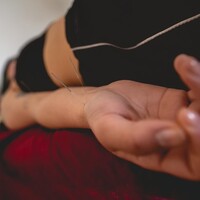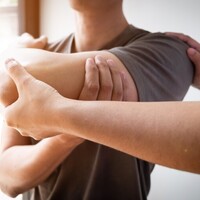
Looking back on the podcast series with Marjolein Frencken
Stoptober: a fresh start for your health
From summer to autumn: letting go and finding balance
From Summer to Autumn: Moving from Earth to Metal
The Acupuncturist’s Toolbox – Pepijn Zuurdeeg on Combining Acupuncture Styles

The Acupuncturist’s Toolbox – Liesbeth Kerkhoff on Dr. Manaka’s Japanese Acupuncture Style
In this series, NVA members share a style or technique that they consider indispensable in their practice. What makes this approach special? What does a treatment look like, and when do they notice that it truly makes a difference for clients? This time, it’s Liesbeth Kerkhoff’s turn, who works extensively with the Japanese acupuncture style of Dr. Manaka.
Which acupuncture style do you use most in your practice and why does this style appeal to you?

'A style I use regularly, but don’t often read about, is that of Japanese physician Dr. Manaka. What appeals to me is that his method provides a solid framework and that I often see excellent results in practice.
I can hardly imagine treating a whiplash or tension-related complaints (which in Chinese medicine are often attributed to a disrupted energy flow in the liver, or liver-Qi stagnation) without applying Dr. Manaka’s principles.
His method consists of four fixed steps. I always start by addressing an energy deficiency, known as the deficiency type. Then I treat specific back points (Back Shu points), using moxa on the needle (kyotoshin). Next, I apply additional techniques suited to the client’s specific complaints, and finally, I assess the balance in the muscles, helping restore it with simple movements if needed.
What I find particularly remarkable is that Dr. Manaka looks beyond the visible complaints. He worked with the concept of a ‘three-dimensional octogram,’ a model that considers deeper energy layers in the body. I often use ion-pumping cords with this, which are threads connecting needles to either enhance or moderate the flow of energy. For me, these have become indispensable tools.'
What does a treatment according to this style look like in practice? Can you give an example of how you treated a specific complaint with this?
'A vital woman in her thirties came to me for an initial consultation. She walked in and immediately asked how long the treatment would take because she had to pick up the kids from school in 45 minutes, then take one to a sports club and the other to horse riding lessons. During the intake, she apologized for not being able to shower before the appointment: she came straight from work and didn't have time in between.
From her story, it became clear that she takes care of a family with growing children while also working 28 hours a week herself. Her husband is often away from home due to his work. She mentioned that she likes to have everything well organized and feels a lot of responsibility in that. She came across as caring and meticulous, but also as someone who easily neglects herself.
Her main complaints were headaches and occasional palpitations for about six weeks. She thought stress played a big role because she felt much better during vacations. The GP and cardiologist found no abnormalities. Some red flags had already gone up for me. During the abdominal and pulse examination, I noticed an energy deficiency that, in the style of Manaka, corresponds to the so-called 4 gates deficiency type (a pattern often associated with stress symptoms).
I started the treatment by restoring liver balance using ion-pumping cords (threads that regulate energy flow). Then, I used the back points of the involved organs, applying moxa on the needle. During the treatment, she clearly felt more calm. Her pulse, which I follow as a diagnostic signal, became softer at the liver position, although not yet fully balanced. It was only after the liver position improved that the role of the gallbladder became clear.
She had tension in her neck and shoulders and mentioned waking up that morning with a slight headache. Despite the time constraints, I also briefly addressed that. We went through a few simple exercises that she could do at home to relieve the tension.
In a subsequent consultation, the same symptoms were present but less severe. She said she already felt somewhat better in herself. After four treatments, the palpitations had disappeared and the headaches were almost gone. She had also scheduled more moments of rest for herself and found a better balance between work and family.'
When do you notice that this style truly makes a difference for a client?
'Especially with complaints where stress and tension play a role, I see results quickly. Often, a client experiences more relaxation during the first treatment, or the pain immediately decreases.'
Do you combine this style with other techniques or approaches? If so, how do you ensure proper integration?
'Yes, I often combine the Manaka method with exercises to relax muscles or with elements from Chinese acupuncture. The beauty is that his step-by-step approach allows me to integrate these smoothly.'
What have you learned over the years about working with this style, and has your approach to treatment changed?
'Over the years, I have mainly learned that Manaka’s style provides structure and guidance. I now look more consciously at the whole picture: the physical complaints, the energy balance, and how a client manages daily stress. This allows me to better tailor my treatments and often achieve faster results.
For that reason, I am very grateful to Dr. Manaka and the teachers from whom I had the privilege of learning this valuable style!'
Curious to read more stories?
With this story, Liesbeth gives a glimpse of how she applies Dr. Manaka’s style in her practice. In this way, she contributes to the versatile toolbox of the acupuncturist, with each style offering its own strengths and possibilities. Curious for more? Keep an eye on our series and read the stories of other acupuncturists about their favorite styles and techniques.
Who was Dr. Manaka?
Dr. Yoshio Manaka (1911–1989) was a Japanese physician and acupuncturist who conducted extensive research on the functioning of meridians and energy pathways in the body. He developed a method consisting of fixed steps and tools such as ion-pumping cords (threads that influence the flow of energy). His style is known for its clear structure and the combination of traditional knowledge with modern insights.










